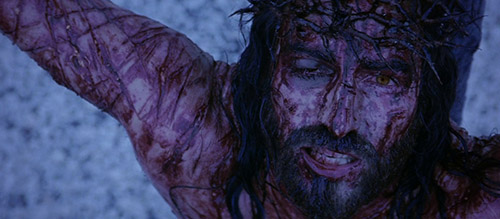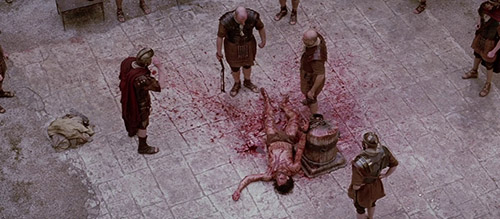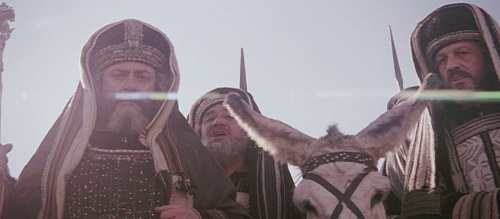Examining Controversial Depictions of Jesus Christ in Cinema
The Passion of the Christ (2004)
Warning: strong images.
The one word I would use to describe the cinematic phenomenon that is The Passion of The Christ is… contradictory.
On a personal level, my feelings towards it are ambivalent. Despite my well documented criticism and general dislike for this film, I can’t deny the impression it left upon me. The graphic violence stunned me at 12 years old and it still probably contributes (on a subconscious level) to my observance of Lent and Easter.
One entertaining dichotomy as reported by IMDB is that it earned the top spot out of the “25 Most Controversial Films of all Time” according to Entertainment Weekly in 2006, whilst readers of Faith and Family Magazine and the National Catholic Register Newspaper voted it as the most Pro-Catholic film of all time. The contradiction that lies within the heart of the controversy that surrounds this movie is contained within Mel Gibson’s announcement of this film’s upcoming production in 2003, in which he said that it would “… tell the whole Gospel Truth about Jesus’ crucifixion.” This can, of course, be proven to be untrue with just a little research.
I have discussed in previous articles the ruckus this film caused upon its release: I remember the palpable excitement in my parish community when a group trip to the cinema of our local congregation was organised.
On an international scale, the film was banned in Bahrain and Kuwait on religious grounds, and there were a reported two fatal heart attacks associated with showings, including 56 year old Peggy Scott of Kansas who collapsed from apparent Heart Failure whilst watching the crucifixion scene.
Amongst all the furore of headlines and soundbites, the most significant was (as reported by Louis Chilton for The Independent): “it is as it was”. The line, which was attributed to then current Pope St. John Paul II was never confirmed by the Vatican, and led some to believe that it was actually a PR stunt. Fake or not, it encapsulated the movie’s most major issue: that its apparent authenticity is used as justification for its unrelenting violence.
With the etymology of the word excruciating, as in the phrase “excruciating pain”, coming from the term crucifixion, it’s not exactly a massive leap of logic to conclude that Jesus’ death, according the Gospels, would have been horrific. However, despite the countless number of television and film adaptions of Jesus’ life, The Passion of the Christ is the first to boast R-rated violence.
In all honesty, I don’t really have a problem with the use of gratuitous violence in cinema; it has often been an integral part of my enjoyment in watching films such as Deadpool or The Evil Dead. Furthermore, in the case of The Passion, some of the most disturbing scenes were used as inspiration for meditations and sermons. Maybe the movie gave Christians a better understanding of Christ’s suffering and thus the central dogma of their faith, but to put it frankly there is no excuse for a film’s production to endanger the lives of its crew or cast.
Jim Caviezel who starred in the titular role has a disturbingly long rap sheet of injuries and ailments associated with his time making this film. He was accidentally whipped during the scourging scene, leaving a 14 inch long scar on his back; he was struck by lightning twice, as was Assistant Director Jan Michelini; and suffered from bouts of pneumonia and hypothermia. Scenes that were kept in the movie where Jim’s skin appears blue wasn’t due to make-up, he was actually turning that colour.
In an interview posted to YouTube, Caviezel recalls the moment he nearly died on set: it was between shots of the crucifixion sequence when an on-set medic listened to his chest and told director Gibson “Mel, he can die!”
Caviezel goes on to describe Mel Gibson as a “gambling man”, as they both agreed to continue filming.
After shooting the film, Caviezel required heart surgery.
Oddly enough, Caviezel tells this anecdote with an almost fond tone. His agreement to continue shooting despite the fact he was desperately sick was a matter “between [him] ans God”, for in that moment “he was ready to go home”.
Caviezel at the time believed that “if [he] died making this movie, so many people would be saved.”
This is a far cry from the likes of Ed Harris who reportedly punched James Cameron in the face after nearly dying while filming The Abyss. Mel Gibson should count himself lucky that his star seemed to take this near-death experience so willingly on the chin.
I do find Caviezel’s statements to be pretty extreme, whilst appreciating that they are in the spirit of the Catholic philosophy that afflictions are the way Christians can “share in the Passion of Christ”, as described by CS Lewis. Personally, I believe the afflictions Lewis refers to are those that are part of the grueling natural chaos of human suffering, such as disease, grief and anxiety, and not the avoidable, figurative or literal self-flagellation that some individuals partake in.
So, Jim Caviezel suffered heart damage whilst filming, which oddly enough academics believe Jesus would have also suffered from during his Passion. But, is The Passion of The Christ the Gospel Truth?
Well, the actual Gospels themselves are rather sparse in terms of details of physical violence. Notable verses include “Then Pilate took Jesus and had him flogged” (John 19:1, Mark 15:15, Matthew 27:26) “And they crucified him”(Mark 15:24) “Then they crucified him”(John 19:18).
Probably the most graphic verse out of all of the Gospels is Luke 22:44…
“And being in agony he prayed more earnestly; and sweat became like great drops of blood falling down to the ground.”
In reality, much of what we see in this film can be attributed to Gibson’s artistic vision. Furthermore, the nature of crucifixion featured in this movie is in contradiction with what we now understand about this method of execution through modern archaeology and the Catholic relic The Shroud of Turin (believed to be the shroud Jesus’ body was wrapped in, which features blood stains and the mysterious image of a man imprinted on it showing historically accurate wounds of crucifixion).
The most obvious inaccuracy is Jesus being nailed to the cross by the palms of his hands. It is, basically, universally acknowledged that victims of crucifixion would be nailed to their crosses by their wrists, as the hands would not be able to support the victims’ full body weight and the nails would simply rip through the hands.
A lesser known inaccuracy is crucifixion via a high cross.
Archaeology, Gospel accounts and The Shroud of Turin suggest that Jesus’ crucifixion would have been on a “Tau” cross, which would have only been about two metres high.
A shorter cross fits with the strange account reported in the Gospels: John 19:34: “…but one of the soldiers pierced his side with a spear, and immediately there came out blood and water”.
To quickly conclude various snippets of evidence, Dr Pierre Barbet M.D., in his book “A Doctor at Calvary”, explains that this odd flow of substances from Jesus’ side is caused by the right atrium being pierced, causing blood and pericardium fluid to flow out.
Apparently, such a blow to the heart that would produce such an effect could not be achieved at the angle that would be produced by a high cross. For example, if the ventricle was instead pierced there would be no flow of blood from the wound. I do of course realise this line of criticism may seem obtuse – plenty of adaptions and artistic works that focus on Jesus’ Passion are historically inaccurate and are still not without spiritual value or are sources of controversy. In the words of Catholic mystic and stigmatic Theresa Neumann, again from Barbet’s book: “Do not think our Saviour was nailed in the hand, where I have my stigmata. These marks only have a mystical meaning.”
However, the violence depicted in The Passion of The Christ does not exist as an isolated concept. Like all art it will leave an impact on its viewers, with some being permanently changed. Deeper examination of this film’s violence and its supposed historical inaccuracies unveils a truly insidious facet of The Passion of The Christ responsible for most of its controversy.
I must confess that my latest rewatches of the movie have left me bored; many elements of its production are deficient, including sub-par writing and direction. What I find particularly irritating is the quality of the supporting characters.
Jesus’ foes, particularly the Hebrew religious leaders, are depicted as one-dimensional bad guys. None of them have any depth or nuance and behave like cartoon villains: they sneer and gleefully rub their hands together at the prospect of Jesus’ soon to be violent end, delighting in grotesque violence. These caricature-like depictions aren’t limited to just the Sanhedrin, as the crowds of Hebrews throughout the film are frenzied and bloodthirsty, even running up to kick Jesus after he’s collapsed under the weight of the cross. They’re also often depicted as being rather physically ugly too. The only Hebrews that are spared this sloppy portrayal are those individuals revered as Christian saints such as Simon of Cyrene and St Veronica.
Many of the Romans are also depicted as being brutal and full of blood lust, but they also often serve as the voice of reason amongst the violent chaos.
Pontius Pilate is the most sympathetic character towards Jesus’ plight and is depicted as being manipulated by the Sanhedrin (whilst historians would state that his administration of Judea was characterised by corruption and violence, and was eager to execute any potential dissidents).
The sight of the Hebrew children’s faces who taunt Judas Iscariot contorting to that of demons solidifies my opinion that this film doesn’t merely push against boundaries but is a flagrant display of grotesque and harmful Jewish stereotypes of the same calibre of films produced by Germany in the 1930s.
And I am not alone in this opinion.
Franco Zeffirelli, whom Gibson had worked with previously on Hamlet (1990) and was the brain behind the outstanding mini-series ‘Jesus of Nazareth’, was reported by Stephen Bates in The Guardian of openly criticising Gibson for depicting the Hebrew people as being “sinisterly attracted to the most unrestrained violence”.
I understand the dangers of pointing the finger with claims of racism and discrimination, and I know I don’t have the authority to condemn the film as antisemitic, but I was undeniably disturbed by how factors from outside the film align with its most controversial moments.
Upon Mel Gibson’s announcement in January 2003 of the movie’s upcoming production, preemptive protests were made by some Jewish Groups, including the Anti-Defamation League (ADL). According to Abraham H. Foxman in the article Mel Gibson’s The Passion of The Christ Legitimizing Anti-Semitism, the ADL tried to contact Mel Gibson and Icon Films (without much luck) for reassurance that the film would not “give rise to the old canard of Jews… and antisemitism” as “Passion plays have an infamous history of leading to hatred, violence and even the death of Jews”.
Regardless of the history of Medieval Passion plays, Mel Gibson’s personal history is cause enough for worry for those who fear resurgence in violence against Jewish people.
Gibson’s father, Hutter Gibson, was a sedevacantist – a Catholic that believes that the occupier of the Holy See (since the death of Pope Pius XII in 1958) is not the true Pope because of the church’s modernist reforms they consider heretical.
Mel himself is not a sedevacantist but is a traditionalist (and, according to IMDB, he stated that he would donate $100 million dollars of the gross income of the movie to the Traditionalist Catholic Movement).
Technically he is not in schism from Rome, but the ultra-orthodox right wing sect he belongs to still rejects the modernist reforms of the Church, particularly those made at the Second Vatican Council.
One document of interest that came out of “Vatican II” was Nostra Aetate, which focused on the Church’s inter-faith relationships. This document famously rejects a former position the church held: it repudiates the decide charge made against all Jewish people for the crucifixion of Jesus.
Catholics cannot accuse Jewish people from the time of Jesus to the modern day for His death – a truly incredible stand to make as this charge has been used as the justification for the antisemitism that has dogged the Church’s history for 2000 years.
Even after seeing the film, the ADL never accused the film or Mel Gibson of antisemitism, although Gibson’s personal comments never helped himself (lest we forget his disgusting tirade when he was arrested for driving under the influence in 2006), but knowing that Gibson’s traditionalist leanings means an inherent rejection of reforms like the Nostra Aetate, the film leaves a bad taste in your mouth.
I share in the concerns of Passion’s opposing Jewish groups – those being that individuals who aren’t familiar with the actual narratives of the Gospels may interpret the film as a direct translation of the New Testament despite being a work of artistic vision inspired by extra-biblical sources.
These concerns may seem like an overreaction – what does it matter if people take the film a little too literally?
Well, Gibson’s evangelical vanity project is part of a trend of post 9/11 American cinema which boast themes of nationalism and conservatism, which in hindsight are symptomatic of the far-right, populist landscape the international community finds itself in.
It is somewhat ironic that The Passion of The Christ seems to be one of the religious illusions Monty Python’s Life of Brian warned us against.




